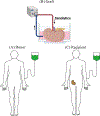The potential of Senolytics in transplantation
- PMID: 34606875
- PMCID: PMC10655132
- DOI: 10.1016/j.mad.2021.111582
The potential of Senolytics in transplantation
Abstract
Older organs provide a substantial unrealized potential with the capacity to close the gap between demand and supply in organ transplantation. The potential of senolytics in improving age-related conditions has been shown in various experimental studies and early clinical trials. Those encouraging data may also be of relevance for transplantation. As age-differences between donor and recipients are not uncommon, aging may be accelerated in recipients when transplanting older organs; young organs may, at least in theory, have the potential to 'rejuvenate' old recipients. Here, we review the relevance of senescent cells and the effects of senolytics on organ quality, alloimmune responses and outcomes in solid organ transplantation. This article is part of the Special Issue - Senolytics - Edited by Joao Passos and Diana Jurk.
Keywords: Aging; Immunosenescence; Old donors; SASP; Senescent cells; Senolytics; Transplantation.
Copyright © 2021. Published by Elsevier B.V.
Figures


References
-
- Anderson R, Lagnado A, Maggiorani D, Walaszczyk A, Dookun E, Chapman J, Birch J, Salmonowicz H, Ogrodnik M, Jurk D, Proctor C, Correia-Melo C, Victorelli S, Fielder E, Berlinguer-Palmini R, Owens A, Greaves LC, Kolsky KL, Parini A, Douin-Echinard V, LeBrasseur NK, Arthur HM, Tual-Chalot S, Schafer MJ, Roos CM, Miller JD, Robertson N, Mann J, Adams PD, Tchkonia T, Kirkland JL, Mialet-Perez J, Richardson GD, Passos JF, 2019. Length-independent telomere damage drives post-mitotic cardiomyocyte senescence. EMBO J 38. - PMC - PubMed
Publication types
MeSH terms
Substances
Grants and funding
LinkOut - more resources
Full Text Sources
Medical
Research Materials
Miscellaneous

